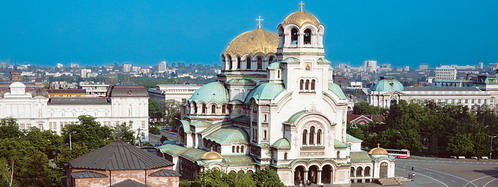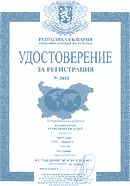Top offers
Hotels Sofia







Sofia
Sofia is the capital of Bulgaria and one of the biggest towns on the Balkan Peninsula (the population is circa 1 250 000 inhabitants). The city lies more than 500 meters above the sea level in the Sofia Valley set from all sides in frame of mountains. The highest of them is Vitosha, turned into a giant park, the favourite recreation place for the inhabitants of Sofia. One can climb the top of the mountain (Cherni vrah – 2290 meters) by a ropeway. In winter the place suits for skiing, in summer for tracking excursions. One of the most breathtaking places in Vitosha is the stone river of cyclopean rocks “Zlatni mostove” (Golden bridges). At the foot of Vitosha in the residential suburb Boyana is the National History Museum; it is placed in the former residence of Todor Zhivkov, the eternal head of the socialist Bulgaria. Among the most famous artefacts are the golden and silver Thracian treasures. It is again here in Boyana the memorial of medieval art the St Panteleymon Church with unique frescos, created in 1259.
Sofia is the second ancient (after Athens) European capital. People settle here since mid III millennium B.C. The Thracian tribe of Serds, who lived here in the I millennium B.C., founded a town near the hot mineral spring, which exists till now. They named that town Serdika. Where the centre of the ancient Serdika was, now there is the St. Nedelya (Resurrection) Church built in the XIX century on the foundations of older buildings. Philipp II of Macedon burned Serdika to ashes in IV century B.C.; no better fortune fell upon the town at the rule of his son, Alexander the Great. At the turn of the I and II centuries A.C. Serdika was conquered and renamed again by the Roman emperor Trayan; now it got his ancestral name, Ulpia. There are little architectural monuments of Thracian and Roman époque left in Sofia: the ancient buildings are in the earth under the centre of the capital. The remains of the defensive installations may be seen in the area of the Central Baths and in the pedestrian subway near Central Department Store. The most significant ancient monument that reached the present days is the Church of St. George (the Rotunda). There are remains of frescos representing two periods: XII century and late XIV- early XV centuries.
The basilica “St. Sofia” remains from Roman times. After the name of this very temple the capital got its today’s mane.
In the V century the town was ruined by the Huns. During the rule of the Byzantine emperor Justinian the town was restored and walled. In 809 the Bulgarian Khan Krum captured Serdika and renamed it Sredets. In the times of Byzantine empire the town got a new name, Triaditsa. Nowadays the Bulgarian capital is called Sofia; the name is first mentioned in a chart granted to the Dragalevtsi monastery by the tsar Shishman in 1382.
In Middle Ages the territory was swept by the Pechenegs, the Serbs, the Magyars, the crusader-knights of the emperor Frederick I Barbarossa. In 1096 during the First Crusade led by Raymond of Saint-Gilles, the count of Toulouse, the knights turned Sofia into their military camp.
In the following centuries during the ottoman yoke Sofia remained one of the largest trade centres in the country. From the 15 mosques built during the period of the Turkish rule three have survived and only one remained in its original state: Hammam-bashi mosque (near the Central Department Store). The Buyuk mosque how hosts the Archaeological museum, and the former Mehmet-pashi or the Black Mosque is rebuilt into a church.
In 1877-1878 broke out the Russian-Turkish war, resulting in Bulgaria’s liberation from the Turkish yoke. On the 4th of January 1978 the Russian army stepped into Sofia. Two years later the Constituent National Assembly in Veliko Tarnovo has declared it a capital of Bulgaria.
In the centre of Sofia on the square of the National Assembly in front of the Bulgarian Parliament there is a monument, erected in honour of the Russian emperor Alexandre II, the Tsar Liberator. Next to this square is the most popular temple in Sofia, the Alexandre Nevski Cathedral, raised in memory of the Russian soldier and officers, fallen in battles for Bulgaria’s liberation. The temple is built upon the project of the Russian architect A.N. Pomerantsev (whose best known project is the building of GUM in Moscow. The construction took eight years (finished in 1912) and the building was raised mainly at the expense of charitable contributions. In the Cathedrals crypt there is a brilliant exposition of Byzantine and Bulgarian icons.
Another temple, dedicated to the Russian soldiers-liberator, is the small church of St. Nicolas or more often called the Russian Church.
The motto of the town is “It grows but doesn’t get old”; and as a matter of fact Sofia has expanded in territory and its population constantly increases. The feverish construction is in full swing, there have been erected many expensive hotels, casinos, entertaining centres and cinemas.
Sofia hotels reviews
- Arena di Serdica reviews Grand Hotel Sofia reviews Hilton reviews Kempinski Hotel Marinela Sofia reviews Radisson BLU reviews Sense reviews Sofia Hotel Balkan reviews Berlin Park Vitosha reviews Best Western Expo reviews Best Western Plus Bristol reviews Central reviews COOP Hotel reviews Crystal Palace reviews Downtown reviews Grami reviews Hill Hotel reviews Les Fleurs Boutique Hotel reviews Metropolitan reviews Park Hotel Vitosha reviews Ramada Sofia reviews Rodina reviews
- Rosslyn Central Park Hotel Sofia reviews Rosslyn Thracia Hotel Sofia reviews Silver House reviews Sveta Sofia reviews Alexander Business Apartments reviews Alexander Palace ADVI reviews Best Western Art Plaza reviews Best Western Lozenetz reviews Budapest reviews Hemus reviews Lion Sofia reviews Madrid Apartments reviews Meg Lozenetz reviews Park Hotel Moscow reviews Renaissance reviews Rila reviews Slavianska Beseda reviews Cheap reviews Medic reviews St Nikola Boutique reviews
Catalog of object in the resort
Museums
Restaurants
MICE (Meeting, Incentive, Conference, Events)
- MICE center Ramada Sofia Hotel - Sofia MICE center Grand Hotel Sofia - Sofia MICE center Best Western Hotel Expo - Sofia MICE center Inter Expo Center - Sofia MICE center Arena di Serdica Residence Hotel - Sofia MICE center Hemus Hotel - Sofia MICE center Central Park Hotel - Sofia MICE center Crystal Palace Boutique Hotel - Sofia MICE center Silver House Hotel - Sofia MICE center Kempinski Hotel Zografski - Sofia MICE center RIU Pravets Golf & SPA Resort - Pravets



